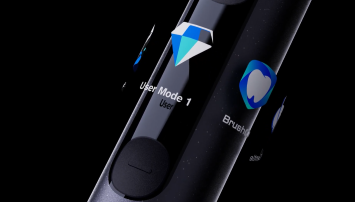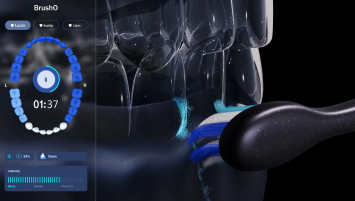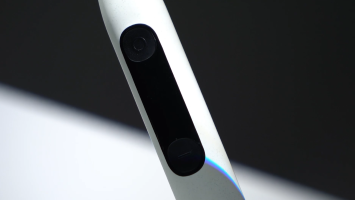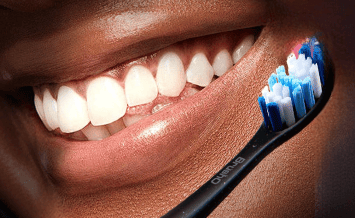Back
Plaque vs. Tartar: What’s the Difference? Aug 26
Aug 26
Plaque vs. tartar: what’s the difference?
Many people confuse the two, but understanding them is key to oral health. Plaque is a soft, sticky film of bacteria that forms daily, while tartar is hardened plaque that can only be removed by a dentist. In this article, we’ll explain how both develop, why they’re harmful, and how using smart electric toothbrushes like BrushO can help you control plaque before it becomes tartar.

What Is Plaque?
Plaque is a colorless, sticky biofilm that constantly forms on teeth and along the gumline. Made up of bacteria, food particles, and saliva, plaque is soft enough to be removed by brushing and flossing. However, when ignored, it produces acids that:
- Attack enamel and cause cavities
- Irritate gums, leading to gingivitis
- Create bad breath and discomfort
Plaque is essentially the “first stage” of dental problems—manageable if treated daily.
What Is Tartar?
Tartar (also called calculus) is hardened plaque that forms when plaque isn’t removed in time. Minerals in saliva cause it to solidify, usually within 24–72 hours. Once hardened, tartar is:
- Yellow or brown in color
- Rough in texture, making teeth harder to clean
- A major contributor to gum disease and tooth decay
Unlike plaque, tartar cannot be brushed away at home. It requires professional cleaning by a dentist or hygienist.
Plaque vs. Tartar: Key Differences
Feature Plaque 🦠 Tartar 🪨
Texture Soft, sticky film Hard, rough buildup
Color Invisible or pale Yellow/brown, visible
Removal Brushing & flossing daily Only by dentist
Health Risk Cavities, gum irritation Gum disease, tooth loss
How to Prevent Plaque from Becoming Tartar
The best way to control tartar is by never letting plaque harden in the first place. Daily habits include:
- Brushing twice a day with a fluoride toothpaste
- Flossing to remove buildup between teeth
- Rinsing with antibacterial mouthwash
- Limiting sugary or starchy foods
- Scheduling dental cleanings twice a year
Why BrushO Is Effective Against Plaque
The BrushO AI-Powered Toothbrush is designed to fight plaque before it turns into tartar:
- High-frequency cleaning power removes biofilm more effectively than manual brushing.
- AI brushing feedback 📱 helps you cover all zones, leaving no hidden plaque behind.
- Pressure sensors 🚦 protect enamel and gums while ensuring thorough cleaning.
- Three replaceable brush heads 🔄 (included per set) provide optimal plaque control for every user.
By using BrushO consistently, you can stop plaque from becoming tartar—and avoid costly dental treatments.
Final Thoughts
So, plaque vs. tartar—what’s the difference?
Plaque is soft and removable with daily brushing, while tartar is hardened, damaging, and requires professional cleaning. The solution? Prevent plaque buildup with the right tools.
👉 With the BrushO AI-Powered Toothbrush, you can protect your teeth daily, stop plaque in its tracks, and keep your smile healthy and bright.
Best Electric Toothbrush for First-Time Users
Aug 27
Why Smart Toothbrushes Are the New Lifestyle Trend
Aug 26
Recent Posts

Better Sleep Starts with Better Brushing
Brushing your teeth properly before bed doesn’t just improve oral health—it may actually help you fall asleep faster and sleep deeper.

How Smart Toothbrush Apps Are Revolutionizing Oral Care
Smart toothbrush apps like BrushO are redefining dental care by blending AI technology with personalized feedback, helping users improve their brushing habits and oral health.

The Right Pressure to Brush Your Teeth
Brushing too hard can cause gum damage and enamel loss—BrushO helps you find the right pressure with smart, real-time feedback.

Why BrushO Is Revolutionizing Oral Care
Brushing twice a day is a habit most of us follow—but are we doing it right? BrushO combines AI, powerful performance, and personalized feedback to upgrade your brushing routine, one smart session at a time.

Why BrushO Is Changing the Way We Care for Our Teeth
BrushO is not just another electric toothbrush—it’s a smart, AI-powered dental companion that transforms daily brushing into a data-driven habit.

Personalizing Your Oral Routine with BrushO
Discover how to tailor your brushing experience using BrushO’s smart modes, app features, and real-time reports. This post explores how BrushO transforms your daily routine into a personalized, data-driven oral care system that adapts to your needs.

Build Brushing Habits with BrushO’s Rewards
Turn daily brushing into a rewarding habit with BrushO’s smart point system.

The Science Behind BrushO — How AI Improves Your Oral Health
Discover how BrushO’s AI-powered technology transforms your daily brushing routine with smart feedback, pressure control, and a personalized oral care experience.

How to Build a 2-Minute Brushing Routine That Works
Struggling to make your brushing routine both short and effective? Discover how to master the ideal 2-minute habit with smart tips and tools—starting with the right toothbrush.

How to Spot Plaque Before It Becomes a Problem
Plaque is invisible—but its damage is real. Learn how to spot and stop plaque buildup before it leads to tooth decay and gum disease.
